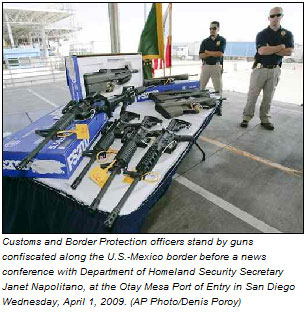US and Mexico get Serious about Gun Flow
Ten million dollars in ARRA funding is hiring 37 ATF employees to open, staff (via new hire and relocation of senior personnel,) equip, and operate new Project Gunrunner criminal enforcement teams in McAllen, TX; El Centro, CA; and Las Cruces, NM (which includes a subordinate satellite office in Roswell, NM.). Additionally, these funds support the assignment of two special agents to each of the U.S. consulates in Juarez and Tijuana, Mexico to provide direct support to Mexican officials on firearms-trafficking-related issues.
 The ATF's eTrace database will be made available to Mexican authorities and will provide web based access to ATF’s Firearms Tracing System to allow law enforcement the ability to trace data from firearms seized in connection with a criminal investigation. Firearm tracing intelligence is critical because it allows ATF and its partners to identify trafficking corridors, patterns and schemes as well as traffickers and their accomplices. Firearms tracing helps identify firearms straw purchasers, the traffickers, trafficking networks and patterns, thus allowing law enforcement to target and dismantle the infrastructure supplying firearms to the drug trafficking organizations in Mexico.
The ATF's eTrace database will be made available to Mexican authorities and will provide web based access to ATF’s Firearms Tracing System to allow law enforcement the ability to trace data from firearms seized in connection with a criminal investigation. Firearm tracing intelligence is critical because it allows ATF and its partners to identify trafficking corridors, patterns and schemes as well as traffickers and their accomplices. Firearms tracing helps identify firearms straw purchasers, the traffickers, trafficking networks and patterns, thus allowing law enforcement to target and dismantle the infrastructure supplying firearms to the drug trafficking organizations in Mexico.
The two programs make up the centerpiece of a new declaration of cooperation between the 10 border governors from the United States and Mexico that aims to eliminate illegal sources of weapons and bring gun traffickers and violent criminals to justice. The "iron river", weapons flowing from U.S. gun stores across the border to Mexico, is going into the hands of drug cartels, who are using them to kill each other and assassinate scores of Mexican police officers and government officials.
By curtailing the availability of firearms to the Mexican drug cartels, ATF will diminish their ability to export drugs to the U.S. In addition, by removing the guns from the cartel’s lethal resources, ATF will directly affect their ability to operate and concurrently suppress the firearms - related violence that occurs on both sides of the southwest border.
By early 2009, Project Gunrunner has resulted in approximately 650 cases by ATF, in which more than 1,400 defendants were referred for prosecution in federal and state courts and more than 12,000 firearms were involved. In 2008, ATF trained more than 750 law enforcement officers from various Mexican federal and state agencies on firearms identification, firearms trafficking, firearms tracing, eTrace, explosives identification and post-blast investigation. With the assistance of ATF’s Mexico City office and the Narcotics Affairs Section of the U.S. Department of State, ATF anticipates conducting numerous additional courses in these subject areas in 2009.
ATF has analyzed firearms seizures in Mexico from 2005 to 2006 and identified the following weapons most commonly used by drug traffickers:
- 9mm pistols
- 0.38 Super pistols
- 5.7mm pistols
- 0.45-caliber pistols
- AR-15 type assault rifles
- AK-47 type assault rifles
Most of the firearms violence in Mexico is perpetrated by drug trafficking organizations (DTOs) who are vying for control of drug trafficking routes to the United States and engaging in turf battles for disputed distribution territories. Hundreds of Mexican citizens and law enforcement personnel have become casualties of the firearms-related violence. DTOs operating in Mexico rely on firearms suppliers to enforce and maintain their illicit narcotics operations. Intelligence indicates these criminal organizations have tasked their money laundering, distribution and transportation infrastructures reaching into the United States to acquire firearms and ammunition. These Mexican DTO infrastructures have become the leading gun trafficking organizations operating in the southwest U.S.